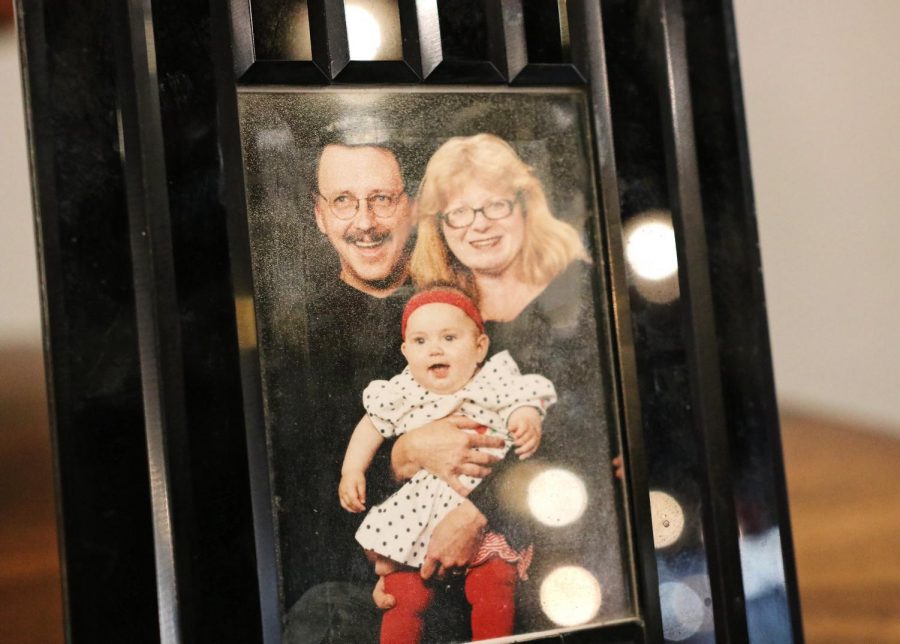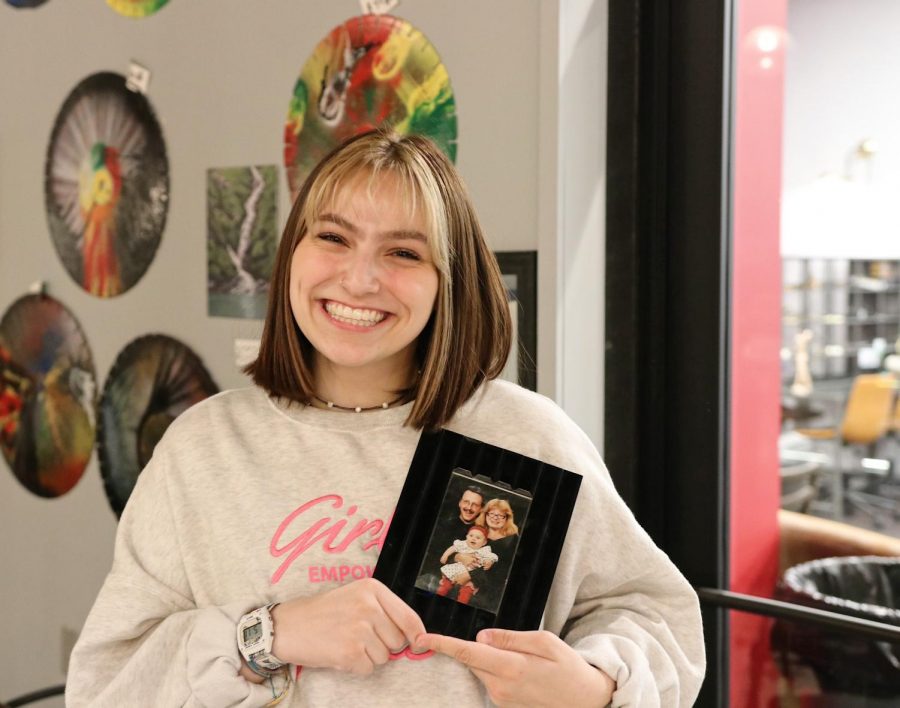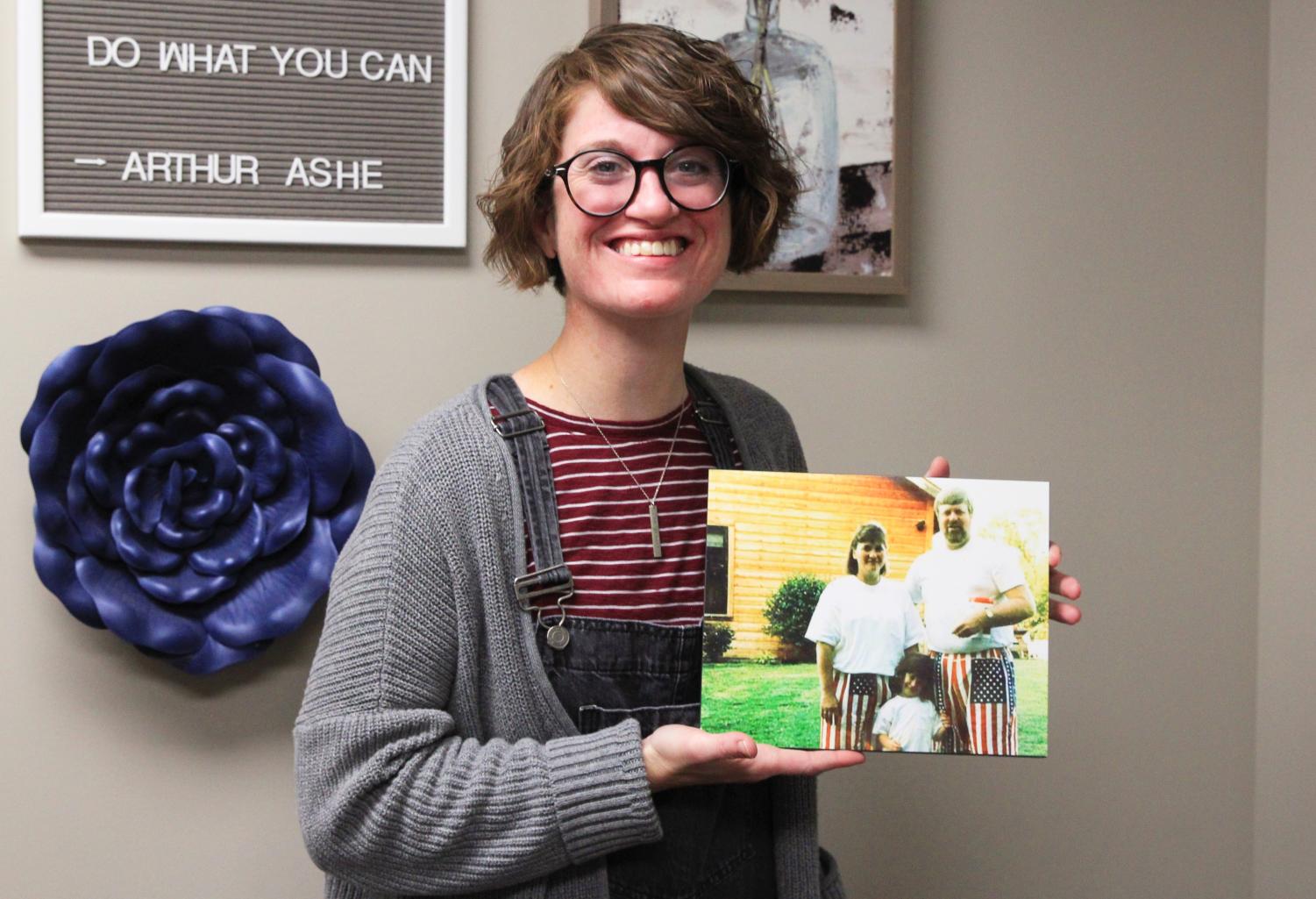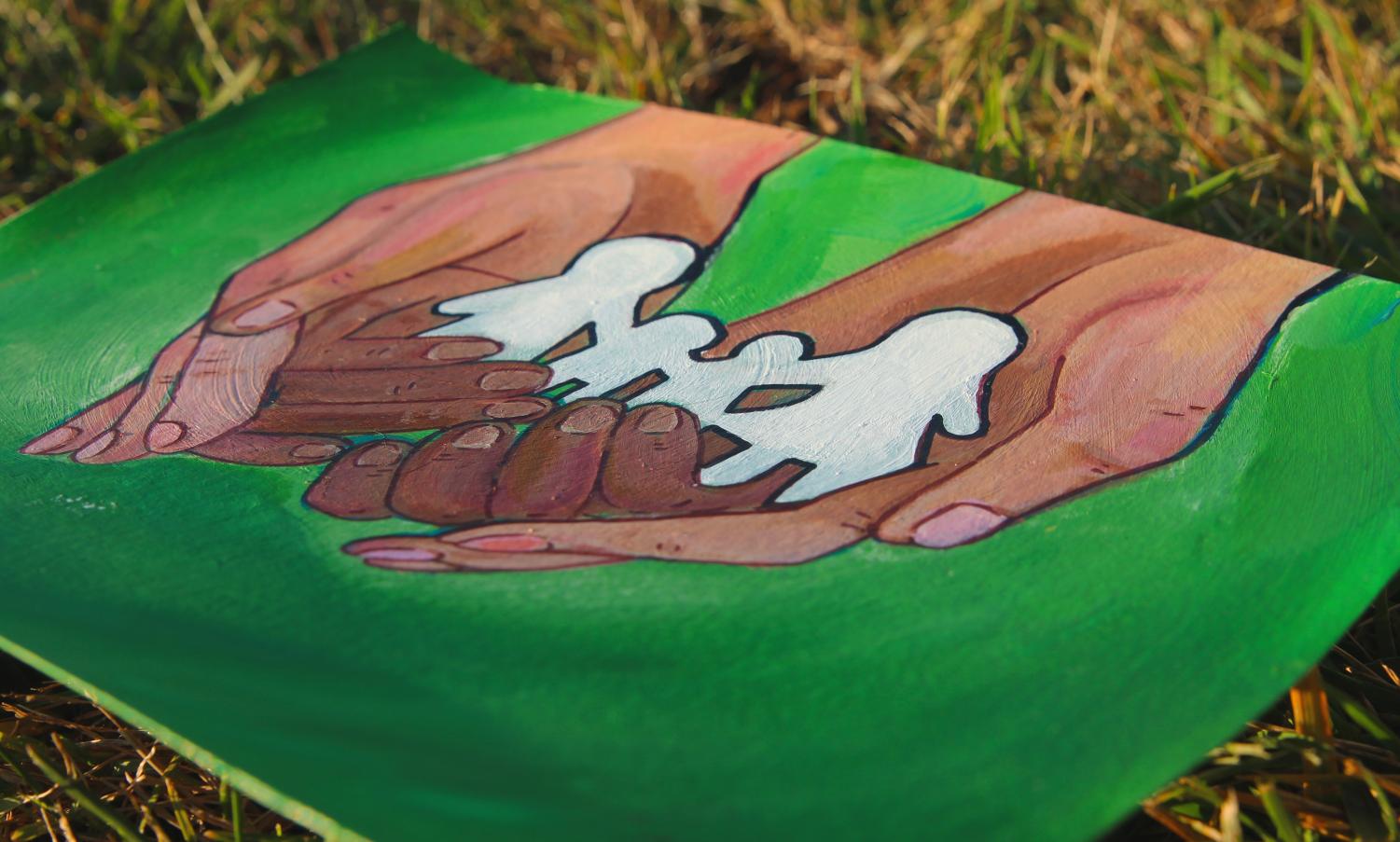Your donation will support the student journalists of Pittsburg High School - KS. Your contribution will allow us to purchase equipment and cover our annual website hosting costs.
The many faces of adoption
November 30, 2020
In honor of National Adoption Awareness Month, members of the Pitt Media staff created a specialty coverage piece on adoption at PHS. In this video, viewers will meet sophomores Keller Erwin and Eve Bertoncino, junior Drake Plain along with senior Emily Wachter as they share their experiences with being adopted.

Photo by: McKenna Hodges
Senior Franchesca Brownhanney poses with a family photo from when she was first adopted.
Adopted senior Franchesca Brownhanney contacts biological sister
Maybe baby, baby maybe?” Darlene Brown sang to her husband Paul Hanney after answering a phone call from the adoption agency, learning that a mother wanted to meet with them.
After going through the adoption process with the state of Kansas for three years, on Dec. 24, 2002, Hanney and Brown went to the Ronald McDonald House Charities of the Four States (RMHC) to bring home their adopted daughter, senior Franchesca Brownhanney, for the first time.
“The birth mother wanted to select which parents she would give her baby to, and she interviewed all four parents,” Brown said. “From the minute we met the birth mother, it was almost as if it was meant to be.”
Prior to adopting Brownhanney, her parents had a home study held within their house for the adoption agency to assess the safety of their home.

“We were blessed to have a woman from the agency in Fort Scott come to our home and interview us,” Brown said. “We could not bring her home because she was born in Missouri and she couldn’t cross the state line, even though the state line was three miles from our house.”
Brownhanney was roughly a month old when she was adopted. From a young age, Brown and Hanney were open to naming their adoptive child Brownhanney as a result of the adoption and encouraged her to embrace her adoptive identity by having her read books about adoption.
“They told me that I was adopted and that they wanted to be 100% honest and open with me. They told me that being adopted was okay and that it wasn’t anything to be ashamed about,” Brownhanny said. “They didn’t make me feel weird about it, they treated it as something that was very normal. It doesn’t feel like I’m adopted, it feels like I’m just their kid.”
Growing up, Brownhanney often asked her parents questions about her biological parents.
“The birth mother made it clear that she really didn’t want an open adoption, but that when she turned 18, Franchesca could contact her,” Brown said. “She asked about her over the years. Particularly around her birthday and Christma

s has been a difficult time for her. I’m sure it’s true for all kids that are adopted.”
However, since the adoption was closed, which means that the record of the biological families information is sealed, most of Brownhanney’s questions remained unanswered until she was given a letter explaining why she was put up for adoption.
“When I was adopted, my biological Mom wrote a letter to me about why she gave me away and told me that Paul and Darlene would keep me safe and give me the best life possible. Based on the letters, she was going through a lot,” Brownhanney said. “I could have been living on the streets or in homeless shelters. It could have been a terrible experience and I’m so grateful that this happened to me.”
After years of wondering about her biological family, Brownhanney recently reached out to her biological sister.
“I found [my biological sisters] Instagram and sent her a message of what I wanted to say. She replied, and it turns out that we have a lot in common,” Brownhanney said. “Her name is Shae and she currently lives in Indiana but plans to visit Joplin soon to visit her family, and I think we’re going to connect then before I go to college.”
According to Brownhanney, her birth mother doesn’t seem to want to contact her.
“As for my mom, I don’t think she wants to connect. My sister had told me that she seemed put-off and surprised that I had even reached out,” Brownhanney said. “I don’t want to open a wound that was long gone or start anything, I just wanted closure.”
Because of Brownhanney’s experiences with being an adopted child and the impact her parents have on her, she plans to adopt in the future.
“Growing up around an environment where being adopted was all I knew and I was taught is probably the biggest factor in me deciding to adopt,” Brownhanney said. “There are thousands of children out in the world right now in the system or about to be, and knowing that I have the ability to change that, like my parents did and acted upon, motivates me to adopt as well.”
According to Hanney, deciding to adopt was one of the best choices he and Brown have made.
“I couldn’t imagine that if we had a child of our own that it would be any different because she was selected for us and it was the best decision we’ve made,” Hanney said. “Everything about the way it turned out is unbelievable. It’s just been a wonderful experience and we have been completely blessed these past 18 years.”
TenMinuteTalks: PHS principal Kelynn Heardt’s experience with being an adoptive mother
As part of honoring National Adoption Awareness month, your host Lane Phifer interviews PHS Principal Kelynn Heardt on her experiences with being an adoptive mother.

Photo by: Lane Phifer
School counselor Stef Loveland poses along side a photo of her and her adoptive parents.
School counselor Stef Loveland shares her experiences with being adopted
On July 15, 1988, Steve and Anne Taylor received a phone call from William Newton Hospital in Winfield, Kansas informing them that their daughter, school counselor Stef Loveland was born.
After nearly eight years of striving to conceive along with several miscarriages, the Taylors OB/GYN Doctor J. Kent Winblad connected them with another patient of his, Jamie, who was looking for a couple to adopt her unborn child.
“My mom had gone through three miscarriages and was working with an OB/GYN. Throughout the process, he knew how badly my parents wanted a child and the pain that they endured along the way. Which led to him asking my parents if they would be interested in adopting me,” Loveland said. “Although my birth mom and adoptive mom never met face to face, it’s almost as if all of their stories became interwoven because they were at the same place at the same time.”
Several months after Loveland began being in the couple’s care, on Sept 12, the court deemed the Taylor’s to become her adoptive parents.
“Adoption for us was no different than having a biological child. Our love for her is so big and it could not be any bigger. Starting from the first day she came home with us, having her in my life has been such a great experience,” Steve Taylor said. “She brought out traits in me that I had no clue I had: love, caring, protectiveness, and amazement. She’s made me laugh and enjoy life even more.”
Despite not being biologically related to her parents, Loveland felt sure from an early age that they were meant to be together.
“I never felt a moment in my childhood where my parents weren’t meant to be my parents. The three of us fit so well together and made sense,” Loveland said. “My parents were always so sure of me and of us and I think that at the end of the day, that’s what made me so sure that they were meant to be my parents.”
Since her adoption, Loveland’s parents were open about it to not only their daughter but the people around her as well.
“My parents have always really believed in the fact that family is family, regardless of how it’s built and they were really open about me being adopted. When I was little, we talked about it as though it was the most normal thing in the world,” Loveland said. “My parents having that conversation with my friend’s parents growing up really helped out in the end.”
Despite all of the positive things that came out of being adopted for Loveland, she has faced some challenges as well.
“My whole life, I haven’t really known a lot about my medical history because I’m adopted and since it was a closed adoption, my parents didn’t know anything either,” Loveland said. “There are parts of my story that I don’t have.”
When Loveland was a freshman in college she decided to reach out to the state to find out more information about her parents.
“I remember when we got in the mail and sitting at the kitchen table with my parents when I opened it up. My dad was crying and my mom was the happiest woman you would ever meet in that moment,” Loveland said. “In the documents, I was able to find their names and back then, I was learning about my own life and it was such a big moment for me and my family”
After Loveland’s mother passed away in May of 2017, Loveland decided to reach out to Jamie two years ago in order to express how much putting her up for adoption meant to her family.
“When my mom died, I felt the need to thank my birth mom because I needed her to know how much my mom appreciated her and what she meant to our family. I had written the letter to my birth mom, but I held onto it forever because it never felt like the right time and she didn’t respond until a year later,” Loveland said. “We’ve been corresponding through Facebook ever since. I’ve learned about my biological siblings, my birth mom’s life, and a little bit about my birth dad, but not a lot.
When Loveland was attending John Brown University, she began giving speeches at adoption conferences in order to share her story.
“I was in college and there was a lady that sat behind me in a class. She knew that I was adopted and she ended up going on about an organization that was created by a team of adoptive moms,” Loveland said. “One weekend every year I get to speak at conferences, hear other people’s stories, answer questions, and even tell my own.”
Due to her own experiences, Loveland and her husband are planning to adopt. However, as a result of the COVID-19 pandemic, the adoption process was postponed until recently.
“When I got married, [my husband] West and I decided that we wanted to adopt, but before we started the process we got pregnant with Shep,” Loveland said. “We are currently in the very beginning of the adoption process where we have to deal with some paperwork, figuring out what we need to do in our home to prepare and how our son is going to react. COVID slowed us down a little bit in March.”
For the past two years, Loveland has been writing a novel about her own experiences with being adopted.
“I began writing my own book about being adopted two or three years ago. Right now there’s a lot of rough drafts and after my Mom died, I put it on hold, but I think that the healing process helped me more with my writing and want to get it out there more,” Loveland said. ‘I’m hoping to get it published within the next three years.”
Being adopted and the effect her mother left on her are some of the main reasons why Loveland became a school counselor.
“At first, I wanted to specifically work with adopted kids and their families, but when my Mom died, I felt like being a counselor was maybe the better route for me since she was a counselor,” Loveland said. “I want to communicate most with adoptive kids is that wherever they are at that moment — whether they want to meet their biological family, feel distant or scared, or even if they simply want to know more about their story, it is okay.”
The Avenue to Adoption
Through the Kansas Department for Children and Families (DCF), the state of Kansas offers adoptive services. DCF is a state agency that offers child support, employment and foster care services in many states.
Adopt Kansas Kids is the adoption authority for the state of Kansas and is sponsored by DCF. According to Adopt Kansas Kids, there are 500 children in the foster care system awaiting adoption.
Dcf.ks.org, the department’s website, says that a child who comes into the custody of the department is evaluated by Child Welfare Case Management Providers, private contractors that partner with DCF to assess a child’s situation, determining the safety of the child’s original home.
“Maintaining a child’s connection to his or her relatives, culture and community is essential,” Kansas DCF said. “Relatives are given first consideration as a placement option for a child, so that if the child becomes available for adoption, his or her relatives are in a position to adopt the child.”
Children whose homes are deemed unsafe are put in the foster care system.
“When it is not possible for a child to go back to the family, parental rights may be taken away by the court or voluntarily surrendered,” Kansas DCF said. “At that point, the child is available for adoption.”
Adoptkskids.org describes the adoption process for prospective adoptive parents.
For Kansas residents, the adoption process follows eight steps. First, contact must be made with Adopt Kansas Kids to receive a list of adoption agencies in the area and detailed information on the remaining steps.
The second step is to choose an adoption agency.
“Select the one you’re most comfortable with and can best meet your family’s needs,” Adopt Kansas Kids said. “If you are not interested in providing foster care, make sure your agency sponsors adopt-only families.”
The next step is to fill out the application to provide basic information about the adoptive family, complete standard background checks and enroll in TIPS-MAPP classes (Trauma Informed Partnering for Safety and Permanence Model Approach to Partnerships in Parenting).
Step four is to complete a home assessment.
“This [step] requires a minimum of two visits to your home. You will be asked about your family history and your expectations for children you hope to parent,” Adopt Kansas Kids said. “Through this assessment the agency will determine if it will continue to support you.”
After the home assessment, Adopt Kansas Kids urges prospective parents to search the organization’s website for a child that interests them and to make the interest known.
“If it is determined your family is a possible match for a child, your family will be included in a Best Interest Staffing,” Adopt Kansas Kids said. “At this meeting, the professionals involved with the child select an adoptive family that best meets that child’s needs.”
After this step, the family that is selected for the child has the option to move on with the Pre-Placement Process and Placement, steps seven and eight. Pre-Placement allows the parent to become familiar with the child before making a final decision.
“You will be able to review the child’s file. You will be able to speak with the child’s current foster parent,” Adopt Kansas Kids said. “You will meet the child. You will have the opportunity to get to know the child through visits.”
If the family decides to become the adoptive family, they will undergo the Placement process.
“The child will join your family. The child’s case manager will continue to provide services until the adoption is legalized,” Adopt Kansas Kids said. “Your agency also may continue to provide support.”


